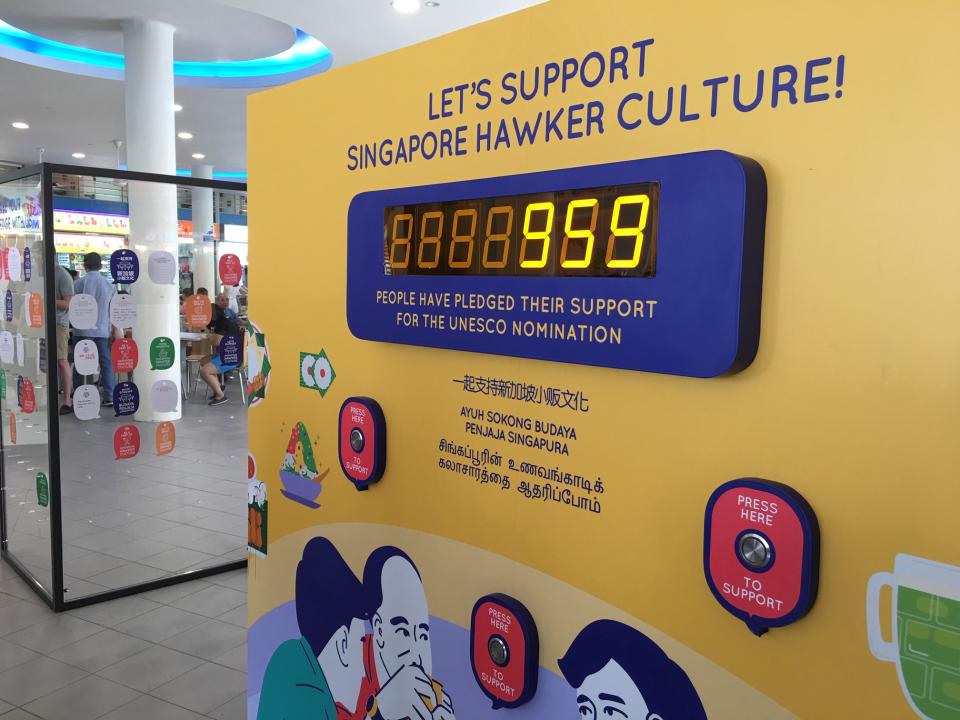People care, so they debate on hawker centre model: NHB
The recent debate on the social enterprise management model for hawker centres is a healthy for Singapore’s bid to place its hawker culture on the UNESCO Representative List of the Intangible Cultural Heritage of Humanity, as it shows that the public cares about the survival of hawker culture.
This is the view of the National Heritage Board (NHB), as it seeks to garner public support for the bid with the launch of Our SG Hawker Culture Exhibition at Tiong Bahru Hawker Centre on Thursday (25 October).
In recent weeks, there has been intense scrutiny placed on hawker centres managed by not-for-profit social enterprises, as news reports highlighted numerous problems faced by proprietors.
They include high rental charges and various fees that the hawkers have to pay to the operators, them having to apply for leave in advance if they choose not to open their stalls, and having to pay penalty fees for terminating their tenancy.
The National Environment Agency (NEA) has said that it would be doing a “stocktake” of the not-for-profit hawker centre model, and will not hesitate to take action against errant hawker centre operators.
“The discussion about operating models for hawker centres actually generates public dialogue on how to safeguard and ensure the long-term sustainability of our hawker culture,” said Alvin Tan, NHB’s assistant chief executive (policy and community), on Thursday.
“Honestly, we find that such dialogue is quite useful, because once the relevant stakeholders come up with solutions, this will reinforce one of the UNESCO nomination criteria of safeguarding the future of our cultural heritage.”
UNESCO is the acronym for the United Nations Educational, Scientific and Cultural Organisation.
UNESCO’s evaluation criteria
There are five evaluation criteria for UNESCO to judge whether a nomination is worthy of putting on its intangible cultural heritage list:
How much it conforms to UNESCO’s definition of an intangible cultural heritage
Whether it is listed in the country’s own list of intangible cultural heritage
Whether it has raised public awareness and discussion
Whether there are safeguarding measures to ensure its sustainability
How much support it has garnered
NHB aims to use its travelling exhibition as another means – other than its website – to garner the public’s support for the nomination. Among the displays is a pledging booth where the public can press a button to signify their support, as well as share why they like hawker culture.

NHB is also hoping to educate the public on why local hawker culture has been chosen for nomination and about timeline for the nomination process.
“While the UNESCO listing will be a welcome achievement, concerted efforts by the public, private and people sectors are needed so as to address the teething issues,” added Tan.
“This will ensure that Singapore’s hawker culture will continue to have a bright and promising future, and new generations of Singaporeans can continue to enjoy delicious and affordable hawker food.”
Committee set up for nomination
On Monday, a 14-member committee was set up to provide recommendations, feedback and advice on the nomination documents for submission to UNESCO in March next year. The United Nations body will announce its selection results at the end of 2020.
Since the list was developed in 2008, there have been 399 elements of intangible cultural heritage added as of 2017. Some examples include the Mak Yong theatre (Malaysia, 2008); Gastronomic Meal of the French (France, 2010); Chinese Shadow Puppetry (China, 2011); Kimjang, or the making and sharing of Kimchi (South Korea, 2013); and Yoga (India, 2016).
The exhibition will be at the Tiong Bahru Hawker Centre until 7 November, after which it will be taken on the road to visit 12 other locations. These include the National Museum of Singapore, Our Tampines Hub, Toa Payoh Hub and Jurong East Library.
Related stories:
NTUC Foodfare debunks allegations of its management of Old Airport Road Hawker Centre
Strong public views on social enterprise hawker centres will lead to change: Makansutra’s K F Seetoh
NEA ‘won’t hesitate’ to take action against errant hawker centre operators: Amy Khor



